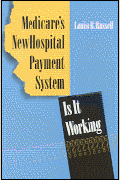What’s the latest in health policy research? The Essential Scan, produced by the USC-Brookings Schaeffer Initiative for Health Policy, aims to help keep you informed on the latest research and what it means for policymakers. If you’d like to receive the biweekly Essential Scan by email, you can sign up here.
Hospital and Skilled Nursing Facility Integration Increases Medicare Payments and Reduces Rehospitalization
Study by: R. Tamara Konetzka, Elizabeth A. Stuart, and Rachel M. Werner
Many recent policy innovations in the field of payment reform like ACOs, pay-for-performance programs, and bundled payments aim to drive down healthcare spending by increasing care coordination among providers and thereby reducing rates of rehospitalization. However, these policies may have the unintended effect of increasing levels of formal and informal vertical integration, which could reduce competition and increase total healthcare spending. A recent study of Medicare data from 2005 to 2013 finds that certain payment mechanisms can be exploited by healthcare providers to maximize payments they receive from Medicare. For instance, the authors find evidence that a program that reimburses hospitals based on the number of days a patient spends in a skilled nursing facility (SNF) can lead hospitals that are integrated with SNFs to shorten hospital stays and increase the number of days a patient spends in an SNF. The authors find that while this policy decreases rates of rehospitalization, it ultimately increases total Medicare payments to hospitals. Conversely, the authors find that programs that encourage informal vertical integration or reimburse hospitals integrated with a home health agency on a per-episode basis had little effect on total Medicare spending or rehospitalization rates. These results suggest that policymakers should be mindful that new payment mechanisms meant to promote care coordination can also lead to increased spending. Full study here.
Medicaid Physician Fee Increases Have Little Impact on Overall Access; Linked to Significant Increases in Utilization of Care
Study by: Kevin Callison and Binh T. Nguyen
The ACA increased Medicaid fees to Medicare levels for primary care services from 2013 to 2014 to help providers handle the pent-up demand predicted to arise from state Medicaid expansion. A new study uses the 2008 and 2012 Medical Expenditure Panel Survey data along with state-level changes in the Medicaid fee schedule for primary care to evaluate the effect of Medicaid fee changes on health care access, utilization, and spending for Medicaid beneficiaries. The researchers found that increases in the Medicaid-to-Medicare fee ratio had little impact on access to care, but significantly increased utilization and out-of-pocket expenditures for beneficiaries. They estimate that a 10 percentage point increase in the fee ratio leads to an 11 percent increase in the number of physician visits, a 14 percent increase in emergency department visits, and an 11 percent increase in Medicaid member prescription fills. They also concluded that the fee increase is associated with a small increase in the probability of beneficiaries reporting an usual source of care. Given the ongoing state Medicaid expansion debate, findings from this study suggests that while a fee increase might lead to increased utilization, it will likely have minimal impact on Medicaid beneficiaries’ access to care. Full study here.
Long-Term Opioid Prescriptions Associated with Significantly Longer Time on Disability for Injured Workers
Study by: Bogdan Savych, David Neumark, and Randall Lea
Opioids, while proven an effective tool for short-term pain relief, have been shown to carry a serious risk of addiction, overdose, and sometimes death. A new study used a novel research design to assess the effect of opioid prescription duration on recovery period following a work-related injury. Specifically looking at work-related, low-back pain injuries between 2008 and 2013, the researchers used local opioid prescribing patterns to examine the relationship between opioid prescriptions and the amount of time the injured worker spends on temporary disability benefits while in recovery. They found that prolonged prescribing of opioids triples the duration of temporary disability benefits among workers with work-related, low-back injuries as compared to workers with similar injuries who are not prescribed opioids, suggesting that long-term opioid prescriptions (which are not typically recommended for low-back pain) may lead to longer disability duration. Full study here.
Drug Overdose Deaths Involving Synthetic Opioids Increased Significantly Between 2010 and 2016, Eclipsing Deaths from Prescription Opioids
Study by: Christopher M. Jones, Emily B. Einstein, and Wilson M. Compton
Deaths from drug overdoses, and specifically opioids, have risen substantially in recent years, and many more of these overdoses have involved heroin and synthetic opioids. A new study analyzes the involvement of synthetic opioids in overdose deaths between 2010 and 2016. The researchers find synthetic opioid involvement in opioid-related overdose deaths has increased from 14.3 percent of opioid-related deaths in 2010 to 45.9 percent in 2016. The 19,413 overdose deaths involving synthetic opioids in 2016 made synthetic opioids the most common drug involved in overdose deaths in the United States, surpassing prescription opioids (17,087 deaths) and heroin (15,469). In addition, the researchers found that almost 80 percent of synthetic opioid-related overdose deaths in 2016 involved another drug or alcohol. These findings provide evidence of how much synthetic opioid use has increased over the years, and point to the need for policymakers to develop comprehensive, multi-pronged strategies that recognize the change in use patterns and corresponding needs. Full study here.

Note: deaths are not mutually exclusive; percentage sum to more than 100%.












Commentary
The essential scan: Top findings in health policy research
May 4, 2018